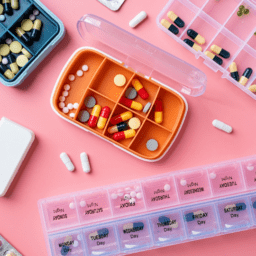In July’s Live Well Today webinar, movement disorder specialist Khashayar Dashtipour, MD, PhD, discussed the past, present, and future of levodopa as a Parkinson’s treatment. This webinar included discussion of available formulations of levodopa as well as new formulations that may be approved soon by the FDA.
While you can watch or listen to the webinar below, consider subscribing to our YouTube page so you can be notified whenever we upload new content.
An audio version of this webinar is available.
SHOW NOTES
THE GOLD-STANDARD PARKINSON’S MEDICATION
Since it was first approved for use in the United States in 1970, levodopa has been the most widely used treatment for Parkinson’s. Typically paired with carbidopa (which helps levodopa cross the blood-brain barrier and also reduces nausea), levodopa helps manage Parkinson’s-related slowness, stiffness, and tremors.
Dr. Dashtipour explained how the development of levodopa was full of trial and error, “failed” studies, and perseverance. For decades, researchers conducted studies and trials and worked to determine conclusively that levodopa was effective and safe as a treatment for Parkinson’s symptoms.
HOW DOES LEVODOPA WORK?
In short, Parkinson's involves decreased levels of dopamine; Levodopa treats symptoms because it is converted to dopamine in the brain.
Dopamine is a neurotransmitter: it helps neurons send messages to each other and to the rest of the body. Dopamine plays a role in movement, mood regulation, sleep, learning, and more. Parkinson’s causes neurons that produce dopamine to die. This leads to less dopamine, which, in turn, leads to the emergence of many Parkinson’s symptoms.
By taking levodopa, you get the benefits of dopamine even though your body’s natural dopamine levels have been impacted by Parkinson’s.
WHEN TO BEGIN TAKING LEVODOPA
People with Parkinson’s typically don’t need to take levodopa for mild symptoms. When your symptoms become disruptive and begin to negatively impact your daily life, however, you should talk with your provider about beginning levodopa therapy (and/or other Parkinson’s treatments).
In the early stages of Parkinson’s, there is sufficient synthesis and storage of dopamine in the brain’s neurons to manage Parkinson’s symptoms with just a few doses of levodopa per day. However, as your Parkinson’s progresses and your brain produces even less dopamine, your body must rely entirely on levodopa to control your symptoms. Your physician may adjust your medication regimen to account for this, or they may work with you to explore new or different treatment options.
HOW TO TAKE Oral LEVODOPA
To make its way from your mouth to your brain, oral forms of levodopa must travel from your stomach to your small intestine, where it is absorbed by an extensive neutral amino acid active carrier system. A similar transport system transfers levodopa across the blood-brain barrier. Levodopa is then metabolized by an enzyme to produce dopamine.
Why does all of this matter? Because the more quickly levodopa reaches the small intestine, the faster it passes through the intestinal walls and the brain’s circulatory system and the more quickly you will feel the effects.
How can you speed up the process? By taking levodopa on an empty stomach with a full glass of water. The water “flushes” the medicine quickly to the small intestine, and the absence of food in your stomach means nothing can slow its emptying. Choosing carbonated water and crushing or chewing carbidopa/levodopa can also help speed the process.
HOW IS LEVODOPA RELATED TO ON/OFF FLUCTUATIONS?
Although the terms ON and OFF have been used to describe responses to levodopa therapy for more than 40 years, there is still no universally agreed-upon definition for the term OFF, and everyone with Parkinson’s experiences it differently. OFF periods occur when your medication isn’t working optimally, and your symptoms return.
OFF times can be impacted by a variety of factors. These include when you eat, how well hydrated you are, and multiple aspects of your digestive health. For example, if you take a dose of levodopa at the same time you eat a large meal, your stomach takes longer to empty, and levodopa doesn’t get into your blood and brain as quickly. As a consequence, you won’t feel the effects of levodopa very quickly (or perhaps at all). Watch the recording above for more about levodopa and ON/OFF fluctuations.
HOW IS LEVODOPA RELATED TO DYSKINESIA?
Dyskinesia is an uncontrolled, involuntary muscle movement that, unlike tremor, is irregular in motion. Parkinson’s-related dyskinesia is generally believed to be caused by a combination of Parkinson’s progression and long-term use of levodopa medications, though Dr. Dashtipour explained that it is the progression of Parkinson’s that plays the most significant role in dyskinesia.
Essentially, dyskinesia occurs most often when your symptoms advance and cause you to have to take more frequent doses of levodopa to manage your movement symptoms. Taking frequent doses of levodopa can lead to “peaks” and “troughs” in the dopamine levels in your brain. These variations can result in dyskinesia.
AVAILABLE FORMULATIONS OF LEVODOPA
There are currently several formulations of levodopa available. These include immediate-release (IR), extended or controlled-release (CR), continuous subcutaneous infusion, and inhaled formulations.
IMMEDIATE-RELEASE CARBIDOPA-LEVODOPA
Currently, this is the most common form of levodopa people take. Immediate-release (IR) carbidopa-levodopa is available in multiple dosages with different amounts of the two medications. The original brand name for this formulation is Sinemet, and this name is still sometimes used today to refer to any IR formulation of levodopa.
There are also two alternative oral formulations of immediate-release carbidopa-levodopa: Dhivy and Parcopa.
- Dhivy is a segmented carbidopa-levodopa pill designed to allow incremental dosing. Dhivy pills include grooves that allow you to break the pill into different sizes, thereby easily adjusting the amount of carbidopa and levodopa you take in each dose.
- Parcopa is a form of immediate-release carbidopa-levodopa that dissolves in your mouth. This form of medication is especially beneficial for people who have difficulties swallowing. Parcopa has been discontinued, but it remains available through some pharmacies.
EXTENDED- AND CONTROLLED-RELEASE FORMULATIONS
Compared to immediate-release carbidopa-levodopa, controlled-release (CR) formulations take longer to have maximum effect. However, studies show that controlled-release doses remain effective longer than immediate-release doses. Sinemet CR was the brand name for a controlled-release formulation approved in 2011. Since 2019, this formulation has been available only as a generic medication. The controlled-release formulation is also sometimes called "delayed-release."
Rytary is a brand name for an extended-release formulation of carbidopa-levodopa. It comes in capsules that contain beads of carbidopa-levodopa that are absorbed at different rates, some quickly and some more slowly. The capsules can also be opened and the medication beads administered in small amounts, which can be beneficial to people with difficulties swallowing.
For many people with Parkinson’s, a dose of controlled-release or extended-release levodopa at bedtime can lead to improved sleep, since levodopa can help manage several of the symptoms that negatively impact sleep (such as stiffness, restless legs syndrome, difficulty turning over or moving side to side, and insomnia). If you primarily take immediate-release levodopa but are experiencing these kinds of sleep challenges, talk with your provider about whether an extended-release formulation might help.
Stalevo
Stalevo is the brand name for another formulation of carbidopa-levodopa. This formulation includes a third medication, entacapone, which is a COMT inhibitor that slows the metabolism of levodopa. For most people who take Stalevo, each dose takes longer than immediate-release formulations and other extended-release formulations to reach maximum concentration in the body.
Inbrija
Inbrija is an inhaled formulation of levodopa that is used to treat OFF periods on an as-needed basis. Inbrija can be used up to five times per day. Data about absorption of the Inbrija does not support replacing oral carbidopa-levodopa with Inbrija. Although Inbrija takes effect faster, less levodopa enters circulation in the body when compared with oral carbidopa-levodopa.
Duopa
Duopa is an infusion system that uses a gel-based form of levodopa. The system requires a surgical procedure and infuses levodopa gel into your intestines using a pump. Because the gel is infused throughout the day, the levels of levodopa in your body should be more consistent than when you take oral formulations. This results in less off-time for many people who use the system, compared to those who use oral medication only.
Emerging LEVODOPA FORMULATIONS
IPX203
IPX203 is an investigational extended-release oral formulation of carbidopa-levodopa developed by Amneal. It contains both immediate-release granules and extended-release coated beads and is designed to maintain steady levels of carbidopa and levodopa in the body. Its formulation is distinct from Rytary, Amneal’s currently-available extended-release carbidopa-levodopa treatment that was approved by the FDA in 2015.
Differences between IPX203 and Rytary from clinical trial data include:
- Five hours after taking IPX203, over 60% of people remained in ON. Less than 30% of people taking Rytary remained ON after 5 hours.
- Taking IPX203 correlated with 1.55 hours of increased ON time, while taking Rytary correlated with 1.16 hours of increased ON time.
Dr. Dashtipour highlighted recent trial results during the webinar, and he noted an additional important finding: people who took IPX203 took far fewer doses of medication each day compared to those who took IR levodopa. An announcement from the FDA about the approval status for IPX203 is expected soon.
CONTINUOUS SUBCUTANEOUS INFUSION LEVODOPA
There are two systems that directly infuse levodopa under the skin in the final stages of review by the FDA in the United States. These devices may be approved within the next year.
Subcutaneous infusion levodopa systems deliver a continuous supply of levodopa through a pump device. The main benefit seen in clinical trials for these new systems has been increased ON-time, but there may be other benefits as well, including potential decreases in dyskinesia and the number of pills taken each day
Trials for one of these drugs, developed by Neuroderm, have found the following key outcomes:
- An average increase of up to 1.72 hours of “good” ON time
- Low rate of withdrawal of participants from the study
For more about this treatment visit Neuroderm, and view this press release for an update from June 2024 about the approval process for this treatment.
Trials for the other of these drugs, developed by AbbVie, have found the following key outcomes:
- Sustained improvements in ON time (an average of as much as 2.72 hours daily) without dyskinesia
- Improvements relative to morning akinesia, sleep quality, and quality of life
For more about Abbvie's continuous infusion system, visit this trial report and view the June 2024 update regarding the status of the approval process.
KEEP THE CONVERSATION GOING
With so many options for levodopa treatment, it’s important to pay attention to how your symptoms feel (whether you’re on or off of medications) and how they might be changing. Share these updates with your care team, and talk with your providers about how various treatment options might work for you.
Additional Resources
An Overview of Levodopa Formulations
How to Take Levodopa for Parkinson’s
The Science of Parkinson’s OFF
Medication, Protein, and Parkinson’s
The Benefits of Duopa for People with Parkinson’s
Clinical Trials for Parkinson’s: A Primer
The Difference between OFF and Parkinson’s Dyskinesia
Diphasic dyskinesia and OFF-state Dystonia: Two Types of Dyskinesia Associated with Parkinson’s
Speaker Bio

Kashayar Dashtipour, MD, PhD
Khashayar Dashtipour, MD, PHD is an Associate Professor of Neurology and Basic Sciences at Loma Linda University. In addition to seeing patients for clinical care in the Loma Linda University Health System, Dr. Dashtipour is the director of the Movement Disorders Division and the Research Director at the Department of Neurology.
Our Live Well Today Webinar Series is supported by our Peak Partners.



















